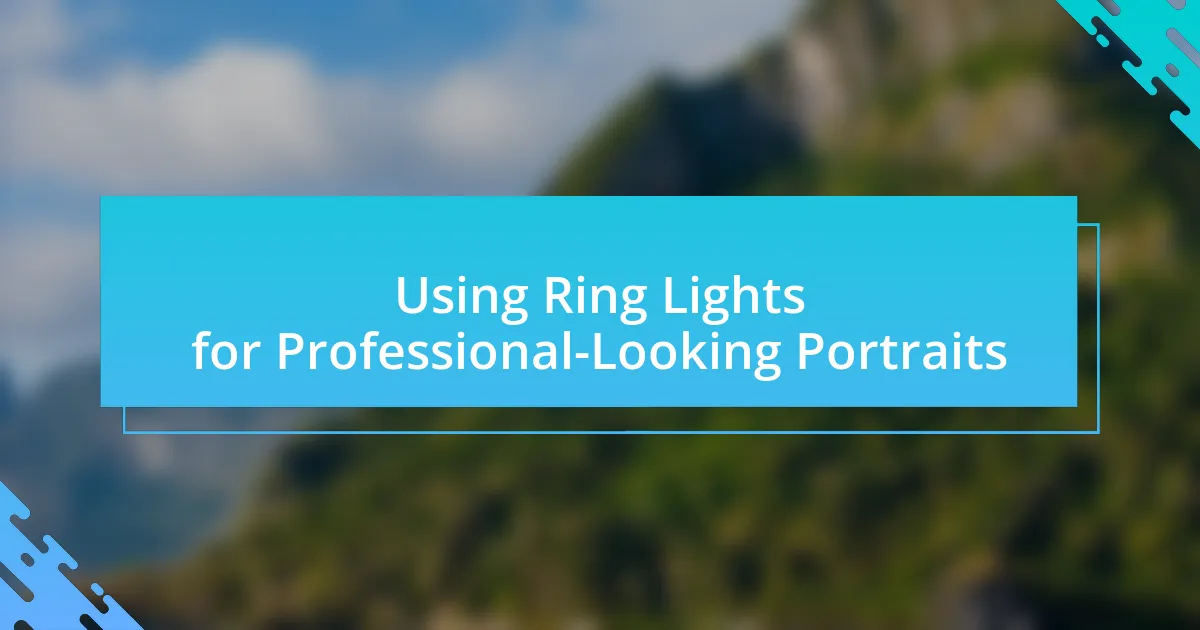The article focuses on the key differences between natural light and artificial light in portrait photography, examining their qualities, advantages, and challenges. It highlights how natural light enhances skin tones and creates a flattering atmosphere, particularly during golden hour, while artificial light offers greater control over intensity and direction. The discussion includes techniques for effectively utilizing both light sources, common pitfalls to avoid, and practical tips for choosing the right lighting for portraits. Additionally, it addresses the impact of time of day and environmental factors on lighting choices, providing a comprehensive guide for photographers to optimize their portrait work.

What are the key differences between natural light and artificial light for portraits?
Natural light and artificial light differ significantly in their quality, color temperature, and control for portrait photography. Natural light, which comes from the sun, provides a soft, diffused quality that can enhance skin tones and create a natural look, especially during golden hour when the light is warm and flattering. In contrast, artificial light, such as studio strobes or continuous lights, offers greater control over intensity and direction, allowing photographers to manipulate shadows and highlights more precisely. Additionally, artificial light can have varying color temperatures, which may require adjustments in white balance to achieve accurate skin tones. These differences impact the overall mood and aesthetic of portraits, making the choice between natural and artificial light crucial based on the desired outcome.
How does natural light influence portrait photography?
Natural light significantly influences portrait photography by providing a soft, diffused illumination that enhances skin tones and reduces harsh shadows. This type of lighting creates a natural and flattering appearance, which is essential for capturing the subject’s features authentically. Studies show that natural light, particularly during the golden hour, can improve the aesthetic quality of portraits by creating warm tones and dynamic contrasts, making the images more visually appealing. Additionally, natural light varies throughout the day, allowing photographers to experiment with different moods and atmospheres, further enriching the portrait’s emotional impact.
What are the advantages of using natural light in portraits?
Using natural light in portraits offers several advantages, including softer shadows, enhanced skin tones, and a more authentic atmosphere. Natural light creates a flattering effect on subjects, as it diffuses through the atmosphere, reducing harsh contrasts that can occur with artificial lighting. Additionally, natural light can highlight the subject’s features more naturally, making skin tones appear more vibrant and true to life. Studies have shown that portraits taken in natural light often evoke a sense of warmth and connection, which can enhance the emotional impact of the image.
What challenges can arise when using natural light?
Using natural light can present several challenges, including variability in intensity and direction, which can affect the quality of the image. For instance, the sun’s position changes throughout the day, leading to inconsistent lighting conditions that can create harsh shadows or overexposed highlights. Additionally, weather conditions such as clouds or rain can alter the availability and quality of natural light, making it unpredictable. Furthermore, natural light can introduce color temperature variations, as sunlight can appear warmer during golden hour and cooler during midday. These factors necessitate careful planning and adaptability when utilizing natural light for portrait photography.
What role does artificial light play in portrait photography?
Artificial light plays a crucial role in portrait photography by allowing photographers to control the lighting conditions, enhance features, and create mood. It enables the manipulation of shadows and highlights, which can significantly affect the subject’s appearance and the overall composition. For instance, using softboxes or umbrellas can diffuse light, reducing harsh shadows and creating a more flattering look. Additionally, artificial light sources, such as strobes or continuous lights, provide consistency in exposure, making it easier to achieve desired results regardless of the ambient light conditions. This control over lighting is essential for achieving professional-quality portraits, as it allows for creative expression and technical precision.
What types of artificial lighting are commonly used in portrait photography?
Common types of artificial lighting used in portrait photography include softboxes, umbrellas, and ring lights. Softboxes provide diffused light that reduces harsh shadows, making them ideal for flattering portraits. Umbrellas can either reflect or diffuse light, offering versatility in lighting setups. Ring lights create a distinctive catchlight in the subject’s eyes and provide even illumination, often favored for beauty and fashion photography. These lighting tools are widely recognized in the photography community for their effectiveness in enhancing portrait quality.
How can artificial light enhance portrait photography?
Artificial light enhances portrait photography by providing controlled illumination that can shape and define the subject’s features. This control allows photographers to manipulate shadows and highlights, creating depth and dimension in the image. For instance, using softboxes or ring lights can produce flattering, even lighting that minimizes harsh shadows, which is particularly beneficial for skin tones. Additionally, artificial light can be adjusted in intensity and color temperature, enabling photographers to achieve the desired mood and atmosphere in their portraits. Studies have shown that portraits taken with artificial lighting can exhibit greater detail and clarity, as the consistent light source reduces the variability often encountered with natural light conditions.
When should photographers choose natural light over artificial light?
Photographers should choose natural light over artificial light when they aim to capture soft, flattering skin tones and a more organic atmosphere. Natural light, especially during golden hour, provides a warm, diffused quality that enhances portraits without harsh shadows. Studies show that natural light can create a more authentic connection in portraits, as it mimics the way the human eye perceives light, making subjects appear more relatable and genuine. Additionally, using natural light can simplify the shooting process, as it often requires less equipment and setup time compared to artificial lighting.
What factors should be considered when deciding between light sources?
When deciding between light sources for portraits, key factors include color temperature, intensity, direction, and quality of light. Color temperature affects the mood and tone of the portrait; natural light typically has a cooler temperature, while artificial sources can vary widely. Intensity determines how bright the light is, influencing exposure and detail in the image. Direction impacts shadows and highlights, which are crucial for creating depth and dimension in portraits. Lastly, the quality of light, whether soft or harsh, affects the texture and overall appearance of the subject. These factors collectively influence the final outcome of the portrait, making them essential considerations in the decision-making process.
How does the time of day affect the choice of light source?
The time of day significantly affects the choice of light source for photography, particularly in portraiture. During the golden hour, shortly after sunrise and before sunset, natural light is soft and warm, making it ideal for flattering portraits. Conversely, midday light is harsh and can create unflattering shadows, prompting photographers to opt for artificial light sources or diffusers to soften the light. Studies show that natural light quality changes throughout the day, impacting color temperature and intensity, which influences the aesthetic outcome of portraits. For instance, the color temperature of sunlight ranges from about 2000K at sunrise to 6500K at noon, affecting how skin tones are rendered in photographs.

What techniques can be used to effectively utilize natural and artificial light?
To effectively utilize natural and artificial light, photographers can employ techniques such as controlling the direction and intensity of light, using reflectors, and adjusting the white balance. Controlling the direction of light involves positioning subjects to take advantage of natural light sources, like windows, while using artificial lights to fill in shadows or create desired effects. Reflectors can bounce natural or artificial light onto the subject, enhancing illumination and reducing harsh shadows. Adjusting the white balance ensures that colors appear accurate under different lighting conditions, which is crucial for achieving the desired aesthetic in portraits. These techniques are supported by the fact that proper lighting can significantly impact the mood and quality of portrait photography, as evidenced by studies in photography and visual arts.
How can photographers maximize the use of natural light?
Photographers can maximize the use of natural light by strategically planning their shoots during the golden hours, which are shortly after sunrise and before sunset. During these times, the sunlight is softer and warmer, reducing harsh shadows and creating a more flattering light for portraits. Additionally, photographers should consider the direction of light; positioning subjects with the light source behind or to the side can enhance depth and texture in images. Utilizing reflectors can also help bounce light onto the subject, filling in shadows without the need for artificial lighting. Studies show that natural light can significantly improve the aesthetic quality of photographs, making it a preferred choice for many portrait photographers.
What are the best times for shooting with natural light?
The best times for shooting with natural light are during the golden hour, which occurs shortly after sunrise and just before sunset. During these times, the sunlight is softer and warmer, creating flattering lighting conditions for portraits. Research indicates that the angle of the sun during these periods minimizes harsh shadows and enhances skin tones, making it ideal for photography.
How can reflectors and diffusers enhance natural light portraits?
Reflectors and diffusers enhance natural light portraits by controlling and modifying the quality of light. Reflectors bounce light onto the subject, filling in shadows and creating a more balanced exposure, which can lead to a more flattering appearance. For instance, using a white reflector can increase the light on the subject’s face without altering the color temperature, resulting in a natural look. Diffusers, on the other hand, soften harsh sunlight, reducing contrast and minimizing harsh shadows, which is particularly beneficial during midday when the sun is at its peak. This softening effect can create a more even and pleasing light on the subject, enhancing skin tones and overall image quality. Studies in photography have shown that the use of reflectors and diffusers can significantly improve the aesthetic quality of portraits by providing more controlled lighting conditions.
What are effective methods for using artificial light in portraits?
Effective methods for using artificial light in portraits include softening the light with diffusers, using reflectors to bounce light, and employing multiple light sources for depth. Softening the light reduces harsh shadows and creates a more flattering appearance, which can be achieved with softboxes or umbrellas. Reflectors can enhance the subject’s features by redirecting light onto them, improving overall illumination. Additionally, using multiple light sources, such as key lights and fill lights, adds dimension and texture to the portrait, making it visually engaging. These techniques are widely recognized in photography for their ability to enhance the quality of portraits.
How can lighting modifiers improve the quality of artificial light?
Lighting modifiers enhance the quality of artificial light by controlling its intensity, direction, and diffusion. These modifiers, such as softboxes, umbrellas, and reflectors, soften harsh light, reduce shadows, and create a more flattering illumination on subjects. For instance, softboxes diffuse light, resulting in a more even and natural appearance, which is particularly beneficial in portrait photography. Studies have shown that diffused light can significantly improve skin tone representation and reduce glare, making the subject appear more appealing.
What are the best practices for positioning artificial lights?
The best practices for positioning artificial lights include placing the light source at a 45-degree angle to the subject, which creates flattering shadows and highlights. This angle helps to define facial features and adds depth to the portrait. Additionally, using softboxes or diffusers can soften the light, reducing harsh shadows and creating a more natural look. Positioning the light slightly above the subject’s eye level can also enhance the effect, as it mimics natural light sources. These techniques are supported by photography principles that emphasize the importance of light direction and quality in achieving professional results.

What are the common pitfalls to avoid when choosing light sources for portraits?
Common pitfalls to avoid when choosing light sources for portraits include relying solely on harsh, direct sunlight, which can create unflattering shadows and highlights on the subject’s face. Additionally, using inconsistent light sources, such as mixing daylight with artificial lights, can lead to color temperature mismatches, resulting in unnatural skin tones. Another mistake is neglecting the importance of light modifiers, which can soften or diffuse light, enhancing the overall quality of the portrait. Lastly, failing to consider the direction of light can lead to unbalanced lighting, diminishing the three-dimensionality of the subject.
What mistakes do photographers often make with natural light?
Photographers often make the mistake of not considering the direction and quality of natural light, which can lead to unflattering shadows and highlights. For instance, shooting in harsh midday sunlight can create strong shadows on the subject’s face, resulting in a less appealing image. Additionally, failing to adjust camera settings, such as ISO and aperture, to accommodate changing light conditions can result in overexposed or underexposed photos. According to a study by the American Society of Photographers, understanding light dynamics is crucial for achieving optimal results in portrait photography.
How can harsh shadows be avoided in natural light portraits?
Harsh shadows in natural light portraits can be avoided by using diffusers or reflectors to soften the light. Diffusers, such as sheer fabrics or specialized photography tools, scatter sunlight, reducing the intensity of shadows. Reflectors can bounce light back onto the subject, filling in shadows and creating a more even illumination. Studies in photography emphasize that shooting during the golden hour, when sunlight is softer, also minimizes harsh shadows.
What are the signs of overexposure in natural light photography?
The signs of overexposure in natural light photography include loss of detail in highlights, where bright areas appear completely white, and a lack of contrast, resulting in flat images. Additionally, overexposed photographs may exhibit color casts, particularly in the highlights, leading to unnatural hues. These indicators are critical for photographers to recognize, as they directly affect the quality and aesthetic of the final image.
What errors should be avoided when using artificial light?
When using artificial light, one should avoid common errors such as improper positioning, incorrect intensity, and inadequate diffusion. Improper positioning can lead to unflattering shadows or highlights, which detract from the subject’s features. Incorrect intensity may result in overexposure or underexposure, compromising image quality. Inadequate diffusion can create harsh lighting, causing unwanted glare and reflections. These errors can significantly impact the overall effectiveness of artificial lighting in portrait photography.
How can color temperature issues be resolved in artificial lighting?
Color temperature issues in artificial lighting can be resolved by using adjustable LED lights that allow for a range of color temperatures, typically from warm (around 2700K) to cool (up to 6500K). This flexibility enables photographers to match the artificial light to the ambient light conditions, ensuring a more natural appearance in portraits. Additionally, using color correction gels or filters can help modify the light’s color temperature to achieve the desired effect. Studies have shown that proper color temperature matching can significantly enhance the quality of portrait photography, improving skin tones and overall image aesthetics.
What are the risks of relying solely on artificial light?
Relying solely on artificial light poses several risks, including negative impacts on health, mood, and the quality of visual output. Prolonged exposure to artificial light, particularly from sources like fluorescent and LED lights, can disrupt circadian rhythms, leading to sleep disorders and increased fatigue. Studies have shown that inadequate exposure to natural light can result in vitamin D deficiency, which is essential for bone health and immune function. Additionally, artificial lighting can create harsh shadows and unnatural skin tones in portrait photography, diminishing the overall aesthetic quality of images.
What are some practical tips for choosing the right light source for portraits?
To choose the right light source for portraits, consider the quality, direction, and color temperature of the light. Quality refers to whether the light is soft or hard; soft light, often from diffused sources, reduces shadows and creates flattering images, while hard light can create dramatic effects. Direction is crucial; front lighting minimizes shadows, side lighting adds depth, and backlighting can create silhouettes. Color temperature affects the mood; daylight (around 5500K) is neutral, while warmer tones (around 3200K) can evoke a cozy atmosphere. These factors are supported by photography principles, where soft, diffused light is commonly recommended for portraiture to enhance skin tones and reduce blemishes.

















